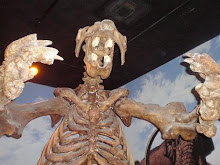
Starting down the trail it becomes apparent that the region is filled with melaleuca. Which is a tall, skinny white tree with bark that almost seems like it's shedding. It is sometimes called the "paper tree" and I remember taking the bark off as a kid and writing on it. My camera ran out of battery halfway down the trail, and so I didn't manage to get a picture of everything I wanted, including the melaleuca, but I have retrieved a photo online at http://images.google.com/imgres?imgurl=http://www.iswgfla.org/templates/Melaleuca05.JPG&imgrefurl=http://www.iswgfla.org/Melaleuca.htm&usg=__WSWfSM8B43XNXRNAUs_FeIx8jcc=&h=2384&w=3628&sz=2532&hl=en&start=4&tbnid=-aTKnWzDPTZjzM:&tbnh=99&tbnw=150&prev=/images%3Fq%3Dmelaleuca%26gbv%3D2%26hl%3Den.
Other, more native species were present in relative abundance, including cabbage palms and saw grass. While sighting these plants, there was clearly evidence of a forest fire, which had seared many palms in some areas. The professor and guide explained that the woods must be intentionally set fire to every so often in a controlled way in order to prevent a natural brush fire from occurring. Pictured below is an example of this.

Here is another example of a toasted palm, along with a beautiful orchid. Orchids were also a common occurrence on the trail.

After hiking down the trail a little more, it was cut off by a large marshland or swamp. Indeed it was an unforgettable experience trudging through the knee high water. I thought it was very relaxing to walk in the water, and as the professor even said, it would go hand in hand with Richard Louv's theory of being in contact with nature as a means of helping your mind and spirit.
There was much tall grass and trees in watershed area, which also would indicate that it is a slough. A kind of tree-laden swamp. Not a whole lot of wild animals to speak of, but there were signs of hog residency.
All and all it was a pleasant experience. I wasn't afraid to get into the water before reaching it, but then thought that I could skirt the outer rim and avoid it, seemed like a a good plan, but the outer rim disappeared after a while, and it wasn't so bad after all.
It was obvious to me that the university was surrounded by a forest, but I had no idea what the forests were harboring. Now I am aware and I believe that areas like the slough here in our backyard definitely need to be protected. They are very beautiful and it is obvious that they are an important part of the ecosystem.

No comments:
Post a Comment